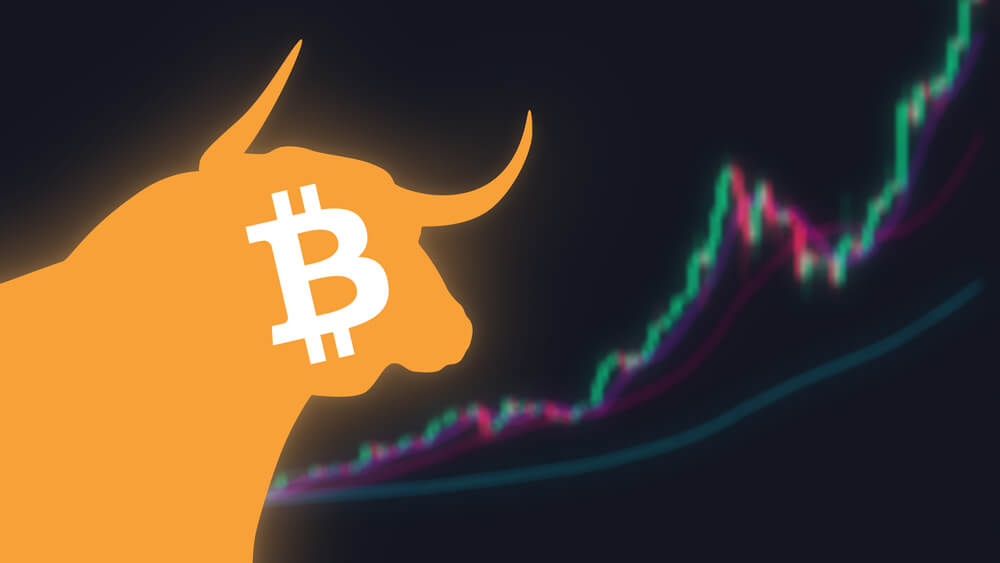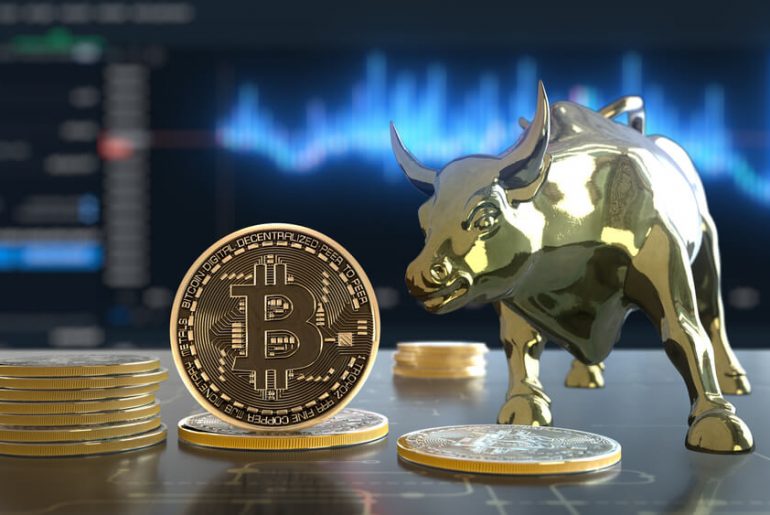The bull run in the crypto market is what every trader and investor anticipates. It provides a lot of opportunities for market participants to make new gains during the uptrend. This article delves into the history of bull runs in crypto and navigates market participants through the main features of such market conditions.
What Does a Bull Run Mean in Crypto?
First, let’s consider the meaning of a bull run in crypto. A bull run, also known as a bull trend, represents a period in the financial market during which the prices of specific assets experience a sustained increase. This upward momentum can result from various market factors, including heightened volatility, increased demand, and favorable market valuations.
Bull Run in the World of Cryptocurrencies
In the realm of cryptocurrencies, a bull run signifies a phase where the value of crypto assets rises steadily over a market cycle. During this period, investor interest in particular digital assets intensifies, driving up demand. When demand significantly outstrips supply, it reflects a bullish sentiment among cryptocurrency investors, which further propels asset prices upward. The valuation process for a crypto asset is intricately tied to investor psychology and market sentiment, making the mindset of investors a critical factor.
The duration of a bull run in cryptocurrency can range from several months to multiple years, but for it to be recognized as a true bull run, this period must be prolonged and sustained. Unlike brief price spikes, a bull run indicates a consistent trend over a significant timeframe.

Understanding Bull Markets
A market experiencing a bull run is referred to as a bull market. This is characterized by sustained price increases and general investor optimism. In contrast, a bear market occurs when asset prices decline over an extended period, reflecting widespread pessimism. The dynamics of bull and bear markets are fundamental to market cycles and investor strategies.
Historical Crypto Bull Runs
The cryptocurrency market, despite its relatively short history, has witnessed several dramatic bull runs, particularly involving its two largest assets – Bitcoin and Ethereum. These bull runs have significantly shaped the market, creating waves of investor interest and substantial price movements.

Bitcoin Bull Runs
2013 Bull Run
In 2013, Bitcoin experienced a monumental bull run, with prices soaring from around $100 to over $1,000 within a year. This surge was primarily driven by increasing mainstream interest and adoption of Bitcoin. The period marked one of the first significant entries of Bitcoin into the broader public consciousness, catalyzing its rise as a legitimate financial asset.
2017 Bull Run
Another historic Bitcoin bull run occurred in 2017. During this period, Bitcoin’s price skyrocketed from under $1,000 to nearly $20,000 in less than 12 months. Several factors contributed to this explosive growth, including the approval of Bitcoin ETFs, heightened regulatory clarity, and broader acceptance by financial institutions and payment companies. Speculation and hype around the burgeoning cryptocurrency market also played significant roles in driving prices upward.

2020-2021 Bull Run
Following its May 2020 halving event, Bitcoin embarked on another substantial bull run that lasted through most of 2020 and early 2021. Bitcoin prices surged from around $5,000 to over $60,000, fueled by institutional investor interest and advancements in mainstream adoption, such as Visa and PayPal integrating crypto payments into their platforms. This bull run underscored the growing acceptance of Bitcoin as a viable investment asset and payment method.
2023-2024 Bull Run
Those who ask a question about when the last crypto bull run was can simply look at the chart right now to see that it’s still in place. Bitcoin managed to break its ATH in the spring of 2024. One of the key reasons for this bull run in Bitcoin was the halving event. However, apart from that, the uptrend in BTC was supported by the expectations of the US Federal Reserve rate cut that was expected in June (currently, economists expect the first step towards expansionary monetary policy to be taken in September).

Drivers and Signals of a Crypto Bull Run
A crypto bull run is characterized by a sustained increase in the prices of cryptocurrencies, driven by a variety of market fundamentals, events, and trends. Key catalysts typically include regulatory developments, institutional investments, mainstream adoption, and specific cryptocurrency mechanisms like Bitcoin halvings. Here’s an expanded look at these drivers and signals.
Regulatory Approval of Spot Bitcoin ETFs
Regulatory approval of spot Bitcoin Exchange-Traded Funds (ETFs) is a major catalyst for a crypto bull run. Spot ETFs allow investors to gain direct exposure to Bitcoin through traditional stock exchanges, significantly increasing accessibility. Regulatory approval can also boost market confidence, as it implies government endorsement and oversight, potentially reducing perceived risks associated with cryptocurrency investments. Such approval signals to both institutional and retail investors that the market is maturing and gaining legitimacy.
Increased Institutional Investor Interest
The involvement of large institutional investors, such as hedge funds, investment banks, and pension funds, is a powerful signal of a potential bull run. Institutions bring substantial capital and credibility to the market, often leading to increased demand and higher prices. Their investments are seen as a vote of confidence in the long-term viability of cryptocurrencies. Additionally, institutional interest often leads to the development of more sophisticated financial instruments and services, further enhancing market stability and liquidity.

Major Companies Offering Crypto Services
Mainstream companies like PayPal, Visa, and Fidelity supporting cryptocurrency payments and services are pivotal in driving mainstream adoption. When established financial services companies integrate crypto into their offerings, it not only validates the utility of digital currencies but also makes them more accessible to a broader audience. This adoption helps normalize the use of cryptocurrencies in everyday transactions, thereby increasing demand and market activity. As more companies enter the space, the ecosystem expands, fostering further growth and innovation.
Bitcoin Halving Events
Bitcoin halvings, which occur approximately every four years, are events where the rewards for mining new Bitcoin blocks are cut in half. This reduction in supply can create a scarcity effect, driving up prices if demand remains constant or increases. Historically, Bitcoin halving events have preceded significant bull runs, as reduced supply coupled with steady or growing demand typically leads to higher prices. The anticipation of these events often sparks increased market activity and speculative investment.

Growing Retail Investor Interest
The swelling interest of retail investors, evidenced through offerings like crypto Individual Retirement Accounts (IRAs), is another significant indicator of a bull run. As more everyday investors seek to include cryptocurrencies in their retirement portfolios, demand increases, contributing to upward price pressure. Retail investors also drive market sentiment and can amplify trends through collective actions, such as social media-driven investment waves.
Launch of New Crypto ETFs
The introduction of new cryptocurrency ETFs, especially those approved by regulatory bodies like the Securities and Exchange Commission (SEC), can signal a cryptocurrency bull run. These financial products provide a convenient and regulated way for investors to gain exposure to the crypto market, thereby broadening the investor base. The approval and launch of such ETFs are often viewed as milestones in the mainstream acceptance and integration of cryptocurrencies within traditional financial systems.
Synergy of Factors Leading to a Bull Run
When these fundamentals align, and the signals accelerate, the stage is set for a potential major crypto bull run. Experts often predict such events to occur in tandem with specific market catalysts, such as the next Bitcoin halving for instance. As regulatory clarity improves, institutional and retail interest grows, and mainstream adoption continues, the combined effect can ignite a significant and sustained increase in cryptocurrency prices.
By understanding these drivers and signals, traders can better anticipate and navigate potential bull runs, positioning themselves strategically to capitalize on market opportunities.

FAQ
What Is a Bull Run in Cryptocurrency?
A bull run in cryptocurrency refers to a period during which the prices of cryptocurrencies experience sustained and significant increases. This upward trend is typically driven by factors such as increased investor interest, positive regulatory developments, and growing mainstream adoption. During a bull run, market sentiment is highly optimistic, leading to higher trading volumes and rising asset values.
How Long is a Bull Run in Crypto?
A bull run in crypto can vary in duration, typically lasting anywhere from several months to a few years. The length of a bull run is influenced by market conditions, investor sentiment, regulatory developments, and technological advancements. Historical bull runs, such as those in 2013 and 2017, lasted around one to two years.





